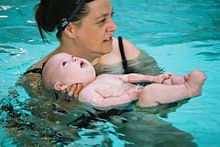Baby swimming

As baby swimming or swimming for infants is called the water aerobics with infants and toddlers between the fourth and the eighteenth month of life.
history
Baby swimming originated in the 1970s. With reference to the fact that unborn babies grow up in a fluid environment, snaking body movements were interpreted as swimming movements. Water safety should be achieved with diving exercises. Today, almost all providers of aqua aerobics in the medical field in German-speaking countries also offer courses for baby swimming if the required water quality can be ensured.
requirements
The pool water must be of drinking water quality (DIN 19643), the entire filter technology must meet the legal requirements. A suitable water temperature for baby swimming is 32–34 ° C, depending on the age of the baby - the younger, the warmer the water should be. The air temperature should not be below 30 ° C and the changing facilities should be adequately heated. The water depth should be 100 to 140 cm. In principle, baby swimming is possible from the sixth week of life. Infants have a respiratory protection reflex, which is often referred to as the diving reflex , which suggests that an infant can dive safely. This reflex disappears in the third to sixth month of life.
Promoting development
The baby's prone position when swimming stimulates the baby's reflex crawling by activating the striated muscles . As a result, the coordination of movement patterns in the central nervous system is activated and stabilized earlier. The support of the reflex creep is also used in various physiotherapies , such as B. Vojta used. The extensive contact stimuli stimulate the nerve fibers located under the skin . This enables relaxation, activates the regulation of muscle tone and leads to longer and deeper sleep for the children.
The head start in performance and the increased self-confidence that the children receive through this form of early intervention will be used up within the next 2-3 years if it is not subsequently built up through various forms of physical activity promotion on this basis.
criticism
Critics note that baby swimming, which is held in so-called “courses”, can also be an expression of excessive early intervention, as a result of which parents overwhelm their toddlers with false ambitions.
Another point of criticism is the health aspect. Infectious diseases such as otitis media, diarrheal diseases and respiratory diseases are more common in babies who take part in the course in the first year of life, as a study by the GSF Institute shows.
At the end of 2010, the Federal Health Gazette raised the suspicion that nitrogen trichloride produced in chlorinated pool water could trigger asthma. The Federal Environment Agency advises against baby swimming, especially for children under two years of age, in whose families there are frequent allergies , until further findings are available that speak in favor of harmlessness. However, there is more recent data showing that baby swimming does not lead to an increased risk of asthma.
literature
- Lilli Ahrendt: Toddler swimming. Fundamentals of child development and support through parent-child swimming in the 2nd and 3rd year of life , Meyer & Meyer, Aachen 2002, ISBN 3-89124-990-X (1 video cassette, VHS, 45 min.)
- Lilli Ahrendt: Infant swimming and child development. Theory and practice of parent-child swimming in the first year of life , Meyer & Meyer, Aachen, 2nd edition 2007, ISBN 978-3-89899-202-2 .
- Gabriele Detrois: Physiological and medical aspects of infant swimming. Investigations into the behavior of body temperature when staying in water. Thesis. Cologne 2001 (PDF; 1.24 MB) .
- Barbara Ahr: Swimming with babies and toddlers , Trias, 3rd edition 2005, ISBN 3-8937-3570-4 .
- Michel Odent , Jessica Johnson: We are all children of water , Kösel, 1995, ISBN 3-4663-4331-3 .
- Francoise Barbira Freedman: Water Babies: Safe Starts in Swimming , Southwater, 2004, ISBN 1-8421-5986-0 .
Individual evidence
- ↑ Arnd Krüger : When should children start exercising? In: Peter Lösche (Hrsg.): Göttinger Sozialwissenschaften today. Göttingen: Vandenhoeck & Ruprecht 1990, 278–308
- ↑ The early intervention mania. Infants with the mammoth program. In: Deutschlandradio online , August 9, 2005 ( online )
- ↑ Health: Baby swimming is not recommended . In: WELT ONLINE . October 11, 2007. Retrieved May 11, 2011.
- ↑ Baby swimming and disinfection by-products in swimming pools. (PDF; 132 kB) Bundesgesundheitsblatt 01/2011, 54: 142–144, December 29, 2010 (published online). doi : 10.1007 / s00103-010-1177-x .
- ↑ Baby swimming: risk of asthma from disinfection with chlorine?
- ↑ L. Font-Ribera, CM Villanueva, MJ Nieuwenhuijsen, JP Zock, M. Kogevinas, J. Henderson: Swimming pool attendance, asthma, allergies, and lung function in the Avon Longitudinal Study of Parents and Children cohort. In: American journal of respiratory and critical care medicine. Volume 183, number 5, March 2011, pp. 582-588, doi : 10.1164 / rccm.201005-0761OC , PMID 20889905 , PMC 3081279 (free full text).
- ↑ Health assessment of trichloramine in indoor pool air. (PDF; 420 kB) Federal Health Gazette 2011, 54: 997-1004, July 30, 2011 (published online). doi : 10.1007 / s00103-011-1326-x .
